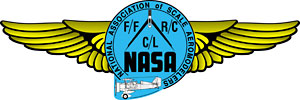Reported by Gerry Garing
Today starts off with a serious feel to it. What does that mean? Thursday was a registration, practice, and if applicable, static judging. Yesterday morning was more registration, practice, and static judging, if applicable. John Boyko held another brief meeting and pilots were off to fuel up, get in line, and be ready to start round 2 flying at 9:00 AM sharp.
The sky was bright, and any wind was very light and right down the runway. The beauty of watching scale competitions is the variety of airplanes and flight routines. Unlike some other events where each pilot flies the same set of maneuvers, the scale pilot chooses a routine consistent with the airplane. A WWI airplane could be flying chandelles, and wingovers, an aerobatic airplane an airshow display, or a warbird flying military maneuvers. This year’s NATS is no exception with 1900’s Curtis Pusher and Royal aircraft F.E.-8 at one end of aviation history to turbine-powered L39 and Grumman Cougar.
Seems like the current trend at the local flying field is one plane in the air at a time. Newcomers to larger contests are often surprised to learn that there are multiple aircraft in the air at the same time. This contest has 4 flight lines running simultaneously, for example. While a midair collision is rare, it can happen, as was the case this morning. A lightweight model ultralight collided with a giant-scale Corsair. Fortunately, it was a glancing collision and both aircraft landed with relatively minor damage.
Some pilots approach the scorekeeper almost as soon as the plane is landed and stops. It is standard procedure that scores for the round are not posted until the round is completed and the scores tabulated. The results are then displayed, and pilots get a chance to see how they did. Imagine a feeding frenzy at a seaside dock and! Competition is brisk as evidenced by the shuffling of positions between rounds 1, 2, and 3. Refer to the score sheets in the photos.
Saturday night is the traditional contest banquet held this year at the Club House in downtown Muncie. Aside from the comradery, awards are given to the high static scores in each class. This year, the highlight of the evening may well be the drawing for the UMS 160 cc radial engine. Check back with tomorrow’s report to learn the winners.
Tomorrow is the last day of the contest and the competition remains stiff!!

District 2 VP Randy Adams and his caller Ron Mienheartt discuss strategy for round 1.

Pitts S2B was flown by Jerry Nugent.

1/3 scale Sopwith Pup flown by Art Shelton. This is from a German kit imported by Vogelsang Aeroscale.

Carbon Cub flown by Rory Hartman entered in Pro-Am Sportsman. A great example of an ARF that is perfect for getting started into R/C Scale.

A large airplane, the Hangar 9 FX-3 Carbon Cub is DLE 170 powered. Flown by Steve Petrotto. The plane is recovered in the Red Bull scheme in Monokote.

CARF models Spitfire co-owned by Mike Wolvin and Jim McDevitt. A 3-cylinder inline ROTO 130 CC engine supplies the power.
Scores from Saturday




